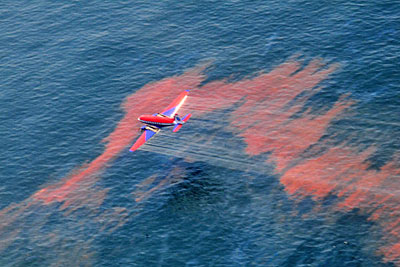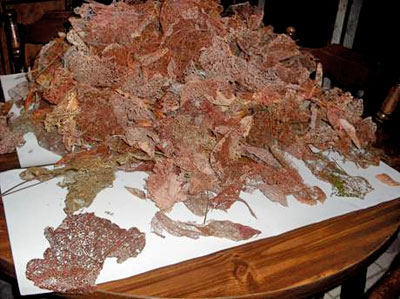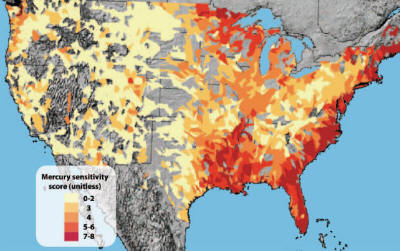|
05 August 2010 from IMVA Website
The Gulf oil disaster has finally shown us the mentality of certain people and corporations as we see fully demonstrated in the above picture.
What we see is extremely low altitude Chemtrail spraying in the Gulf. And of course it’s considered safe as are all extremely dangerous chemicals and heavy metals by the government and the corporations that use them.
This spraying of Corexit is certified by
the EPA as being a
safe hell to breathe in though early on in the
disaster it was reported that the EPA warned BP not to use it.
Over 40% of adults living within ten miles of the coast said they
have
Someone or a group of some ones should probably be shot for what they have done to the southern United States with Corexit for it is doubtful that any medical protocol, no matter how brilliantly designed, is going to be able to protect the animals, plants and people in a wide region around the Gulf of Mexico.
Corexit is an
agent that has been shown to break down lipid membranes, which cover
and protect human skin and cover each and every human cell and
absolutely no one on the planet has every worked with this kind of
toxicity before.
Over one-third of parents report that their children
Human skin and cell membranes are composed of a thin layer of lipids and Corexit, by nature, breaks down these organized barriers into smaller individual molecules allowing the barrier to become permeable to pathogens.
The skin irritation could be caused by
prolonged exposure to these chemicals and could break down the
ability of the body to fight off infection and on a cellular level
interfere with the health and respiration of the cells.
My prediction is that we will be dealing with the
The fact that it can cause rupture of red blood cells indicates that it can severely damage cell membranes.
Cell membranes consist of a mixture of lipids (about 30%), proteins (about 50%), cholesterol, and some carbohydrates. A key portion of the membrane is the lipid bilayer that consists of phospholipids.
Any disruption of this lipid bilayer is likely to cause dysfunction of the membrane that lead to membrane rupture (as is known to be the case with red blood cells and corexit), increased cell membrane permeability (allowing toxins to penetrate the cell), and disrupted cell-cell communication causing overall organism dysfunction and possible death.
Since corexit has been designed to disrupt and disperse lipids/oils,
exposure of the body’s cells to this chemical through inhalation,
skin absorption, or ingestion is likely to cause severe organ
dysfunction.
Oil toxicity is
one hugely damning thing but oil mixed and dispersed with Corexit is
quite another.
Dispersants have never been applied on this scale, leaving
There is great concern that the dispersant BP used so widely will do more harm than the oil itself that leaked into the Gulf.
The corporate monster British Petroleum chose to “cover their trail” by releasing disturbingly excessive amounts of Corexit onto the area of the spill.
By dispersing the oil, BP and the Americans who own it
hoped to reduce the scope of the devastation, at least in terms of
diminishing their financial liabilities since the amount of
measurable oil they can be fined for is thereby reduced.
The EPA asked BP to stop using Corexit, which is banned in
The Coast Guard routinely approved BP requests to use thousands of gallons of the chemical per day to break up the oil in the Gulf, despite a federal directive to use the dispersant rarely, the investigators said.
The Coast Guard approved 74 waivers over a 48-day period after the Environmental Protection Agency order.
Rep. Edward Markey, D-Mass., released a letter Saturday that said instead of complying with the EPA restriction,
Back at the end of June Yobie Benjamin, writing for the San Francisco Chronicle, was reporting about a mysterious disease that has stricken crops in Mississippi.
The disease has caused widespread damage to plants from weeds to farmed organic and conventionally grown crops.
On July 20th I got a letter from a woman living in Missouri who wanted to let me know that the wild vines that are on her property were dying and look like rusted lace.
She started noticing these around June 22nd and they continue to die especially after a rain. Also now other leaves are dying and seem to have holes and brown spots in them. Leaves from hickory trees, poison ivy and basically almost all other vegetation seem to have this. She has lived on this property for 14 years and has never seen anything like this.
She felt sure that this is from the oil spill and the chemicals used.
More than a third report children with new rashes or breathing
By the beginning of August cries have started,
It seems they have only made the devastation much worse with the use of 2 million gallons of dispersant.
No one knows how light
or severe the long-term effects will be but it’s beginning to look
like we can assume the worst even up to and including the
possibility of impacting the Gulf currents, which will have great
impacts on the weather in the North Atlantic and Europe. It makes
sense that the currents would be altered by changing the viscosity
of the water and we do have the first reports of
the stalling of the
Gulf Loop Current.
This is because the
Loop Current
is a crucial element of the
Gulf Stream itself and why it is
commonly referred to as the “main engine” of the Stream. If worst
case scenarios come to pass hundreds of millions of people, if not
billions, will be wishing certain people, governmental organizations
and corporations never existed.
Corexit is banned in the United Kingdom but was approved for use in the Gulf of Mexico by the Environmental Protection Agency.
Oil dispersants trap oil and hold
it in globules in the water instead of allowing it to rise to the
surface where it can evaporate or be more easily collected. By
keeping the oil away from the surface and therefore away from the
shore, BP is minimizing its costs of cleaning up oil that reaches
the shore and minimizing the amount of the fines that can be imposed
upon them.
They’ll be measured at four sites off the
coast of Louisiana, Mississippi, Alabama and Florida. Earlier
samples from Louisiana alone showed that by June 7, concentrations
of the toxic chemicals had risen 40 times higher than levels on May
1, although the water looked clear of oil.
The greatest concern, added Ouchley, is what impact the undersea oil concentrations could have on the billions of tiny larval fish, shrimp and other organisms that are at the bottom of the whole marine food chain - and we may not know that for many years.
And it’s the same for the health effects on adults and the future for many children in the northern Gulf.
No one in the Gulf is calculating the damage or the threat accurately for residents there are already under heavy attack from mercury-polluting smokestacks.
The government has never admitted the true dangers of this heavy metal, which is a potent neurotoxin.
Add the exposure to a large percentage of the local population due to mercury-containing dental amalgam, and now it’s almost flu season meaning the government is going to want to swoop into the area with its mercury-containing vaccines.
One 33-year-old woman said that upon seeking medical advice at a clinic, she was told she had scabies.
Hours later, she was told by an area hospital that she had a staph infection. The woman was treated with a shot of penicillin and Elimite cream, a topical agent for the treatment of scabies mite infestations, and an oral antibiotic.
In addition to the lesions, the woman reported aching
bones, weight loss, stomach pains, inflammation in her leg and sties
developing in her eyes. No consideration is given to toxin exposures
from the Corexit mixed with the oil.
In fact the neurotoxin pesticide that is lethal to 50% of life in concentrations as little as 2.6 parts per million has been banned for use in the UK since 1998 because it failed the UK’s “Rocky shore test” which assures that the dispersant does not cause a “significant deleterious ecological change” - or to put that in laymen’s terms, it can kill off the entire food chain.
But since the
American government feels threatened by its own people, and takes
great pride in treating us cruelly while lying about so many things,
it comes as no surprise that they would create the greatest gas
chamber the world has ever known for its own people.
Yet you will
be astonished to see at the end of this chapter that the company who
makes Corexit says it’s no more toxic than chocolate or ice cream. I
kid you not!
While writing Sound Truth and Corporate Myths, Dr. Riki Ott uncovered Exxon’s clinical data showing 6,722 workers, out of a total of 11,000, reported upper respiratory illnesses.
In 2003, a Yale grad student, Annie O’Neill, conducted a pilot study that showed roughly one-third of these workers continued to suffer symptoms of chemical exposure.
The oil spill's toxic trade-off
Cleanup workers were the first to experience dizziness, fainting,
nausea, nosebleeds, vomiting, coughing, headaches, stomach upset,
and difficulty breathing, compounded by heat, fatigue, hydrocarbon
smell, and combined toxicity of oil and dispersants.
...and other diseases.
Even though “lab tech” Dr. David Horsup, VP of research and development for Nalco, the company that makes Corexit, says there’s no danger of the dispersant making its way into the food chain, there seems to be some disagreement:
|





